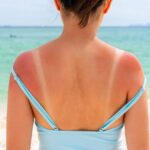Tame sunburn pain with these 3 natural remedies
 (NaturalHealth365) Clear skies, blue water, and silky sand under a radiant sun – is there a more perfect recipe for summer bliss? But, without common-sense precautions, even this glorious experience can send you home with a painful souvenir: sunburn.
(NaturalHealth365) Clear skies, blue water, and silky sand under a radiant sun – is there a more perfect recipe for summer bliss? But, without common-sense precautions, even this glorious experience can send you home with a painful souvenir: sunburn.
An inflammatory reaction caused by overexposure to the sun’s ultraviolet rays, sunburn affects one out of three Americans every year. Fortunately, minor cases of sunburn can be addressed with natural interventions that help minimize damage and speed healing. If you realize too late that you’ve overdone it on the sun, you may want to whip up one or more of these cooling, evidence-based sunburn soothers.
Chamomile tea contains a “trifecta” of healing compounds to ease sunburn
Brewed from the yellow-and-white flowers of the chamomile plant, chamomile tea contains bisoprolol, chamazulene, and apigenin – a trio of antioxidant, anti-inflammatory compounds that can accelerate cell renewal and soothe irritated skin. Botanically known as Matricaria recutita, chamomile also has antimicrobial properties that help prevent skin infections. Highly prized in herbal healing for its therapeutic properties, chamomile has earned the endorsement of many contemporary practitioners as well.
For example, board-certified cosmetic dermatologist Dendy Engelman, M.D., FACMS, FAAD, advises topical chamomile for skin care. While clinical research on chamomile for skincare is limited, animal studies suggest that the essential oil can alleviate atopic dermatitis. To use, simply soak a clean washcloth in cooled chamomile tea and place it over sunburned areas. Before using chamomile tea to ease sunburn, check with your holistic healthcare provider. And don’t use it if you are allergic. (A sensitivity to ragweed and members of the aster family – such as daisies, marigolds, and chrysanthemums – makes a reaction more likely).
Cool sunburn with aloe vera gel
Aloe vera gel, from the spiky plant botanically known as Aloe barbadensis, has a venerable history in herbal medicine for alleviating burns. Aloe’s therapeutic effects are believed to arise from its content of aloin, an anthraquinone with antibacterial, anti-inflammatory, and painkilling properties. (Antioxidant vitamins and beneficial fatty acids may also contribute to aloe vera’s ability to maintain moisture and promote skin healing).
Aloe vera’s reputation received a solid boost in 2022 when a review published in Cureus showed that aloe vera gel was superior to silver sulfadiazine in speeding the healing of second-degree burns.
Many holistic doctors advise using pure aloe vera gel straight from the plant. Snip the leaves close to the stem, where healing compounds are the most concentrated. After washing and drying, trim the spiky edges and scoop out the clear gel at the center. Apply the chilled gel to affected areas several times a day. If you don’t have access to a live aloe plant, try to purchase 100 percent pure aloe vera gel rather than an “aloe-based” lotion or cream, which may contain alcohol or other irritants. Of course, check with your holistic doctor before using aloe vera for sunburn.
Baking soda is a trusted “old-school” remedy for sunburn
Sodium bicarbonate – commonly known as baking soda – can be a surprisingly effective remedy for sunburn. With a pH of 9, this alkalizing powder seems to have the “right stuff” for reducing pain and calming inflamed tissues. Simply mix two tablespoons with enough cool water to make a paste. Apply, leave on for ten minutes, and carefully rinse off.
Alternately, you can add three heaping tablespoons of baking soda to a tub of cool water and soak for 20 minutes. For a calming aroma and added comfort, splash in a few drops of lavender essential oil, which has been shown in studies to have mild painkilling and relaxant properties.
After a baking soda bath, you should apply a gentle, dye-free moisturizer or oil intended for sensitive skin. Convenient, inexpensive and safe, good old-fashioned baking soda can be a useful weapon against sunburn. Again, get the “thumbs-up” from your holistic physician before trying baking soda on your sunburn.
When should you seek medical attention?
Doctors note that this depends on the severity, or degree, of the burn. A first-degree burn can cause the familiar redness, tenderness and pain – possibly with peeling skin in the later stages. However, the damage is confined to the outer layer, or epidermis, of the skin. A second-degree sunburn affects both the epidermis and the dermis beneath – and is a more serious matter. If your sunburn is accompanied by blistering, fever and/or chills, or if the pain and swelling limits your ability to function, seek prompt medical care. Incidentally, you should avoid, breaking or popping sunburn blisters, which raises the risk of infection.
You should also avoid the use of Benzocaine. Formerly considered a “go-to” for sunburn, this topical numbing agent has fallen out of favor in recent years because it can exacerbate skin irritation and even trigger allergic reactions.
Keep in mind, repeated sunburns can result in permanent damage to the skin and even raise your risk of skin cancer. Wearing appropriate sunglasses, hats, long-sleeved shirts, and pants can help minimize your risk. Use a mineral-based sunscreen free of oxybenzone. And remember: you can still get burned on hazy or overcast days.
In the event that you do overdo your sun exposure, here’s hoping that these natural solutions provide some cooling relief!
HHS.gov
Forbes.com
Healthline.com
SkinCancer.org
Healthline.com
Wellness.guide
NIH.gov
Prevention.com



